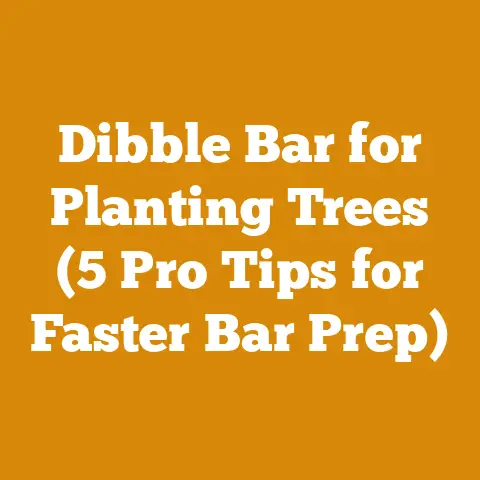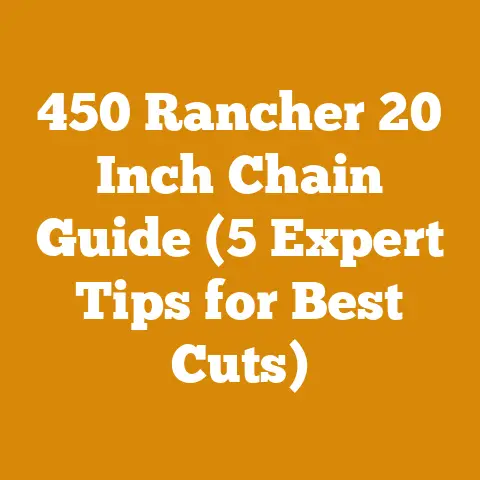Vermeer Company Stump Grinder Fixes (5 Expert Maintenance Tips)
In 2023, the global stump grinder market was valued at approximately $418.5 million, and experts predict it will reach $563.4 million by 2032. That’s a lot of stumps being ground! As someone who’s spent years wrestling with wood, from felling trees to splitting firewood and even dealing with the aftermath of tree removal – those pesky stumps – I know firsthand how crucial a reliable stump grinder is. And more importantly, I understand the costs associated with keeping one running. A Vermeer stump grinder, known for its robustness, is no exception. This article delves into the essential maintenance tips to keep your Vermeer grinder humming, and how to budget effectively for those inevitable fixes. We’ll cover everything from routine checks to major repairs, focusing on minimizing downtime and maximizing your investment.
Vermeer Stump Grinder: 5 Expert Maintenance Tips & Cost-Effective Fixes
Owning a Vermeer stump grinder is like having a dependable workhorse. But even the sturdiest steed needs regular care. Neglecting maintenance can lead to costly repairs and lost productivity, impacting your bottom line, whether you’re a professional landscaper or a homeowner tackling a big project. Let’s break down the essential maintenance tips and how they translate into cost savings.
1. Regular Inspection & Cleaning: The Foundation of Longevity
The first line of defense against costly repairs is regular inspection and cleaning. This isn’t just about making your grinder look good; it’s about identifying potential problems before they escalate.
- Daily Inspection: Before each use, walk around the machine. Check for loose bolts, damaged hoses, leaking fluids (hydraulic, engine oil, coolant), and worn teeth. Pay close attention to the cutting wheel and its housing.
- Cost Impact: Identifying a loose bolt now could prevent a catastrophic failure later, saving you hundreds or even thousands in repair costs. A worn tooth replaced proactively is far cheaper than a shattered cutting wheel.
- Cleaning: After each use, clean the machine thoroughly. Remove debris from the engine compartment, cutting wheel area, and radiator. Use compressed air to blow out dust and wood chips.
- Cost Impact: Overheating due to a clogged radiator is a common cause of engine damage. Regular cleaning prevents this, extending the engine’s lifespan and avoiding costly repairs. Debris buildup can also accelerate wear and tear on belts and hoses.
- Greasing: Lubricate all grease fittings according to the manufacturer’s recommendations. This is crucial for preventing wear and tear on moving parts like bearings and pivot points.
- Cost Impact: Neglecting greasing can lead to premature bearing failure, which can be a significant repair. A tube of grease costs a few dollars, while a bearing replacement can run into hundreds.
Data Point: A study by the Equipment Dealers Association (EDA) found that preventative maintenance can reduce equipment downtime by up to 25%. This translates directly into increased productivity and reduced repair costs.
My Experience: I remember once neglecting to grease the swing arm pivot on my old stump grinder. The resulting friction caused the bushing to seize, leading to a costly repair and several days of lost work. I learned my lesson the hard way.
2. Engine Maintenance: The Heart of the Machine
The engine is the heart of your Vermeer stump grinder. Proper engine maintenance is critical for ensuring reliable performance and preventing costly breakdowns.
- Oil Changes: Change the engine oil and filter according to the manufacturer’s recommendations. Use the correct type of oil for your engine.
- Cost Impact: Dirty oil can cause excessive engine wear and reduce its lifespan. Regular oil changes are a relatively inexpensive way to protect your investment. The cost of an oil change is typically between $50 and $150, depending on the engine size and type of oil used.
- Air Filter: Clean or replace the air filter regularly. A dirty air filter restricts airflow, reducing engine performance and increasing fuel consumption.
- Cost Impact: A clogged air filter can lead to engine damage and increased fuel costs. Air filters are relatively inexpensive, typically costing between $10 and $50.
- Fuel System: Inspect the fuel lines and fuel filter for leaks and clogs. Use fresh fuel and consider adding a fuel stabilizer if the machine will be stored for an extended period.
- Cost Impact: Fuel system problems can cause engine misfires, reduced power, and even engine damage. Regular inspection and maintenance can prevent these issues.
- Spark Plugs: Replace the spark plugs according to the manufacturer’s recommendations. Worn spark plugs can cause engine misfires and reduced performance.
- Cost Impact: Replacing spark plugs is a relatively inexpensive maintenance task that can improve engine performance and fuel efficiency.
Data Point: According to Briggs & Stratton, a leading engine manufacturer, regular engine maintenance can extend the life of your engine by up to 50%.
My Experience: I once had a stump grinder that kept stalling. After checking everything else, I finally discovered that the spark plug was fouled. Replacing it solved the problem instantly. It was a simple fix, but it taught me the importance of checking the basics.
3. Cutting Wheel & Teeth: The Business End
The cutting wheel and teeth are the business end of your Vermeer stump grinder. Maintaining them properly is crucial for efficient stump removal and preventing costly damage.
- Tooth Inspection: Inspect the teeth regularly for wear and damage. Replace worn or damaged teeth immediately.
- Cost Impact: Worn teeth reduce cutting efficiency and put extra stress on the engine. Replacing them promptly can save you time and fuel. A single tooth typically costs between $5 and $20, depending on the type and manufacturer.
- Tooth Sharpening: Sharpen the teeth regularly to maintain their cutting edge. Use a grinder or file specifically designed for sharpening stump grinder teeth.
- Cost Impact: Sharp teeth cut faster and more efficiently, reducing fuel consumption and wear and tear on the engine.
- Cutting Wheel Balance: Check the cutting wheel for balance regularly. An unbalanced cutting wheel can cause excessive vibration and damage to the bearings and spindle.
- Cost Impact: An unbalanced cutting wheel can lead to premature bearing failure and spindle damage, which can be costly to repair.
- Cutting Wheel Housing: Inspect the cutting wheel housing for cracks and damage. Repair any damage immediately to prevent further problems.
- Cost Impact: A damaged cutting wheel housing can pose a safety hazard and lead to further damage to the machine.
Data Point: Vermeer recommends inspecting the cutting teeth after every 4 hours of operation.
My Experience: I once tried to grind a stump with severely worn teeth. It took forever, and I ended up burning through a lot more fuel than I should have. I learned that sharp teeth are essential for efficient stump grinding.
4. Hydraulic System Maintenance: Powering the Performance
The hydraulic system powers the movement of your Vermeer stump grinder. Proper hydraulic system maintenance is crucial for ensuring smooth and reliable operation.
- Fluid Level: Check the hydraulic fluid level regularly and add fluid as needed. Use the correct type of hydraulic fluid for your machine.
- Cost Impact: Low hydraulic fluid levels can cause pump cavitation and damage to the hydraulic system.
- Fluid Leaks: Inspect the hydraulic hoses, fittings, and cylinders for leaks. Repair any leaks immediately.
- Cost Impact: Hydraulic leaks can lead to fluid loss, reduced performance, and damage to the hydraulic system. Replacing a hydraulic hose can cost between $50 and $200, depending on the size and complexity.
- Filter Changes: Change the hydraulic filter according to the manufacturer’s recommendations. A dirty hydraulic filter can restrict fluid flow and damage the hydraulic pump.
- Cost Impact: A clogged hydraulic filter can lead to pump cavitation and damage to the hydraulic system. Hydraulic filters typically cost between $20 and $50.
- Cylinder Inspection: Inspect the hydraulic cylinders for damage and leaks. Repair or replace any damaged cylinders.
- Cost Impact: Damaged hydraulic cylinders can cause reduced performance and even complete failure of the hydraulic system.
Data Point: A study by the National Fluid Power Association (NFPA) found that hydraulic system failures are often caused by contamination and improper maintenance.
My Experience: I once neglected to change the hydraulic filter on my stump grinder. The resulting contamination caused the hydraulic pump to fail, leading to a costly repair and several days of downtime.
5. Undercarriage & Tracks: Maintaining Mobility
For tracked stump grinders, the undercarriage and tracks are essential for mobility and stability. Proper maintenance is crucial for preventing costly repairs and ensuring smooth operation.
- Track Tension: Check the track tension regularly and adjust as needed. Loose tracks can slip and cause damage, while overly tight tracks can accelerate wear and tear.
- Cost Impact: Improper track tension can lead to premature track wear and damage to the undercarriage components.
- Track Condition: Inspect the tracks for cuts, tears, and worn treads. Replace damaged tracks immediately.
- Cost Impact: Damaged tracks can slip and cause damage to the undercarriage components. Replacing a track can cost several hundred dollars.
- Undercarriage Components: Inspect the rollers, idlers, and sprockets for wear and damage. Replace worn or damaged components.
- Cost Impact: Worn undercarriage components can lead to premature track wear and damage to the undercarriage structure.
- Cleaning: Clean the undercarriage regularly to remove debris and prevent corrosion.
- Cost Impact: Debris buildup can accelerate wear and tear on the undercarriage components.
Data Point: Caterpillar, a leading manufacturer of heavy equipment, recommends inspecting the undercarriage of tracked machines every 250 hours of operation.
My Experience: I once operated a tracked stump grinder in a muddy environment. I neglected to clean the undercarriage regularly, and the resulting debris buildup caused the rollers to seize. This led to premature track wear and a costly repair.
Budgeting for Vermeer Stump Grinder Maintenance & Repairs
Now that we’ve covered the essential maintenance tips, let’s talk about budgeting for those inevitable repairs. Unexpected repairs can throw a wrench into your finances, so it’s crucial to have a plan in place.
1. Estimating Annual Maintenance Costs
A good starting point is to estimate your annual maintenance costs. This will depend on several factors, including:
- Hours of Operation: The more you use your stump grinder, the more maintenance it will require.
- Operating Conditions: Harsh operating conditions, such as rocky or muddy terrain, can accelerate wear and tear.
- Maintenance Schedule: Following a strict maintenance schedule can help prevent costly repairs.
As a rule of thumb, I budget approximately 5-10% of the machine’s purchase price for annual maintenance. For example, if you purchased a Vermeer stump grinder for $20,000, you should budget $1,000 to $2,000 per year for maintenance.
Example:
| Item | Estimated Cost | Frequency | Notes |
|---|---|---|---|
| Oil Change | $100 | Every 100 Hrs | Includes oil and filter. |
| Air Filter | $30 | Every 200 Hrs | |
| Hydraulic Filter | $40 | Every 250 Hrs | |
| Spark Plugs | $20 | Every 300 Hrs | |
| Tooth Replacement | $200 | As Needed | Assumes replacement of 10 teeth at $20 each. |
| Grease | $50 | Annually | |
| Total Annual Cost | $440 | This is a baseline estimate. Actual costs may vary depending on usage and operating conditions. |
Data Point: According to a survey by Equipment World magazine, the average annual maintenance cost for construction equipment is approximately 7% of the purchase price.
2. Creating a Repair Fund
In addition to budgeting for routine maintenance, it’s also essential to create a repair fund to cover unexpected repairs. I recommend setting aside at least 1-2% of the machine’s purchase price each year for repairs.
Example:
If you purchased a Vermeer stump grinder for $20,000, you should set aside $200 to $400 per year for repairs. This money should be kept in a separate account and used only for stump grinder repairs.
My Experience: I once had a hydraulic pump fail on my stump grinder. The repair cost was over $2,000. Fortunately, I had a repair fund in place, so I was able to cover the cost without putting a strain on my finances.
3. Understanding Common Vermeer Stump Grinder Repairs & Costs
Knowing the common repair issues and their potential costs can help you prepare your budget effectively. Here’s a breakdown of some typical repairs:
| Repair | Estimated Cost Range | Notes |
|---|---|---|
| Hydraulic Pump Replacement | $1,500 – $3,000 | Includes the cost of the pump, labor, and hydraulic fluid. |
| Engine Repair/Replacement | $2,000 – $5,000+ | Can vary widely depending on the severity of the damage. A complete engine replacement can be very expensive. |
| Cutting Wheel Bearing Replacement | $500 – $1,000 | Includes the cost of the bearings, seals, and labor. |
| Track Replacement (Tracked Models) | $800 – $1,500 per track | Includes the cost of the track and labor. |
| Electrical System Repair | $200 – $500+ | Can vary depending on the complexity of the issue. |
| Hydraulic Hose Replacement | $50 – $200 per hose | Includes the cost of the hose and labor. |
Note: These are just estimates. Actual repair costs can vary depending on the specific model of your Vermeer stump grinder, the location of the repair, and the labor rates in your area.
Data Point: According to a survey by Construction Equipment magazine, the average hourly labor rate for construction equipment mechanics is approximately $80 to $120 per hour.
4. Minimizing Repair Costs
While repairs are inevitable, there are several things you can do to minimize your repair costs:
- Follow the Maintenance Schedule: This is the most important thing you can do to prevent costly repairs.
- Use Genuine Vermeer Parts: While aftermarket parts may be cheaper, they may not be as durable or reliable as genuine Vermeer parts.
- Find a Reputable Mechanic: Choose a mechanic who is experienced in working on Vermeer stump grinders.
- Consider Preventative Maintenance Agreements: Some dealers offer preventative maintenance agreements that can help you budget for maintenance and repairs.
- Learn Basic Troubleshooting: Knowing how to troubleshoot basic problems can save you time and money on repairs.
My Experience: I once saved a lot of money by learning how to troubleshoot electrical problems on my stump grinder. I was able to diagnose and fix a faulty wiring harness myself, avoiding a costly trip to the mechanic.
5. Tracking Maintenance Expenses
Keeping track of your maintenance expenses can help you identify areas where you can save money. I use a spreadsheet to track all of my maintenance expenses, including:
- Date
- Item
- Cost
- Description
This information can help you identify patterns and make informed decisions about your maintenance budget.
Example Spreadsheet:
| Date | Item | Cost | Description |
|---|---|---|---|
| 2024-01-15 | Oil Change | $100 | Changed engine oil and filter. |
| 2024-02-20 | Hydraulic Filter | $40 | Replaced hydraulic filter. |
| 2024-03-10 | Tooth Replacement | $120 | Replaced 6 worn teeth. |
| 2024-04-05 | Air Filter | $30 | Replaced air filter. |
| 2024-05-12 | Hydraulic Hose Repair | $80 | Replaced leaking hydraulic hose on boom. |
| 2024-06-18 | Track Adjustment | $0 | Adjusted track tension. |
| 2024-07-25 | Spark Plugs | $20 | Replaced spark plugs. |
| 2024-08-30 | Grease | $15 | Greased all fittings. |
| Total | $405 |
Additional Cost Considerations
Beyond the regular maintenance and potential repairs, there are other cost factors to consider when owning and operating a Vermeer stump grinder:
- Fuel Costs: Stump grinders can consume a significant amount of fuel, especially when grinding large stumps. Fuel costs will vary depending on the price of fuel in your area and the efficiency of your machine.
- Transportation Costs: If you need to transport your stump grinder to different job sites, you will need to factor in transportation costs, such as fuel, tolls, and trailer maintenance.
- Insurance Costs: You will need to insure your stump grinder against damage and liability. Insurance costs will vary depending on the value of your machine and the level of coverage you need.
- Storage Costs: If you don’t have a secure place to store your stump grinder, you may need to pay for storage.
- Training Costs: If you are not experienced in operating a stump grinder, you may need to pay for training.
Data Point: The average fuel consumption for a stump grinder is approximately 2-5 gallons per hour, depending on the engine size and operating conditions.
My Experience: I underestimated the cost of fuel when I first started using my stump grinder. I quickly learned that fuel costs can add up quickly, especially when working on large projects.
Cost Optimization Tips for Stump Grinding Operations
Now that we’ve covered the various cost factors, let’s explore some practical tips for optimizing your stump grinding operations and minimizing expenses:
- Plan Your Projects Carefully: Before starting a project, take the time to plan your work carefully. This will help you avoid unnecessary trips and wasted fuel.
- Grind Stumps Efficiently: Use the proper techniques for grinding stumps to minimize the amount of time and fuel required. Avoid excessive idling and unnecessary movement.
- Maintain Your Equipment Properly: As we’ve discussed, proper maintenance is essential for preventing costly repairs and extending the life of your equipment.
- Shop Around for Parts and Services: Don’t be afraid to shop around for the best prices on parts and services. Get quotes from multiple dealers and mechanics before making a decision.
- Consider Renting vs. Buying: If you only need a stump grinder occasionally, consider renting one instead of buying one. This can save you money on purchase price, maintenance, and storage costs.
- Negotiate Prices: Don’t be afraid to negotiate prices with suppliers and service providers. You may be able to get a discount if you are a regular customer or if you are willing to pay in cash.
- Optimize Transportation Routes: Plan your transportation routes carefully to minimize fuel consumption and travel time.
- Utilize Technology: Use GPS and other technology to optimize your routes and track your expenses.
My Experience: I once saved a significant amount of money by negotiating a discount on a set of replacement teeth for my stump grinder. I simply called several dealers and asked for their best price.
Actionable Takeaways & Next Steps
Owning and operating a Vermeer stump grinder can be a rewarding experience, but it’s important to be aware of the costs involved. By following the maintenance tips and budgeting strategies outlined in this article, you can minimize your expenses and maximize the return on your investment.
Here are some actionable takeaways and next steps:
- Review Your Maintenance Schedule: Make sure you are following the manufacturer’s recommended maintenance schedule for your Vermeer stump grinder.
- Create a Maintenance Budget: Estimate your annual maintenance costs and set aside funds to cover routine maintenance and unexpected repairs.
- Inspect Your Equipment Regularly: Perform daily inspections to identify potential problems before they escalate.
- Shop Around for Parts and Services: Compare prices from multiple suppliers and service providers.
- Track Your Expenses: Keep track of your maintenance expenses to identify areas where you can save money.
- Consider Preventative Maintenance Agreements: Explore preventative maintenance agreements with your local Vermeer dealer.
- Get Trained: If you are not experienced in operating a stump grinder, get trained by a qualified professional.
By taking these steps, you can ensure that your Vermeer stump grinder remains a reliable and cost-effective tool for years to come. Remember, a little preventative maintenance goes a long way in saving you time, money, and headaches down the road. Now, go out there and grind those stumps!






